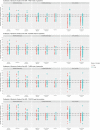Mental Health Through the COVID-19 Quarantine: A Growth Curve Analysis on Italian Young Adults
- PMID: 33132973
- PMCID: PMC7566042
- DOI: 10.3389/fpsyg.2020.567484
Mental Health Through the COVID-19 Quarantine: A Growth Curve Analysis on Italian Young Adults
Abstract
Introduction: Health emergencies, such as epidemics, have detrimental and long-lasting consequences on people's mental health, which are higher during the implementation of strict lockdown measures. Despite several recent psychological researches on the coronavirus disease 2019 (COVID-19) pandemic highlighting that young adults represent a high risk category, no studies specifically focused on young adults' mental health status have been carried out yet. This study aimed to assess and monitor Italian young adults' mental health status during the first 4 weeks of lockdown through the use of a longitudinal panel design.
Methods: Participants (n = 97) provided self-reports in four time intervals (1-week intervals) in 1 month. The Syndromic Scales of Adult Self-Report 18-59 were used to assess the internalizing problems (anxiety/depression, withdrawn, and somatic complaints), externalizing problems (aggressive, rule-breaking, and intrusive behavior), and personal strengths. To determine the time-varying effects of prolonged quarantine, a growth curve modeling will be performed.
Results: The results showed an increase in anxiety/depression, withdrawal, somatic complaints, aggressive behavior, rule-breaking behavior, and internalizing and externalizing problems and a decrease in intrusive behavior and personal strengths from T1 to T4.
Conclusions: The results contributed to the ongoing debate concerning the psychological impact of the COVID-19 emergency, helping to plan and develop efficient intervention projects able to take care of young adults' mental health in the long term.
Keywords: Achenbach adult self-report; coronavirus disease 2019; growth model; internalizing/externalizing problems; mental health; quarantine; young adult.
Copyright © 2020 Parola, Rossi, Tessitore, Troisi and Mannarini.
Figures





Similar articles
-
A longitudinal study on clinically relevant self-reported depression, anxiety and acute stress features among Italian community-dwelling adults during the COVID-19 related lockdown: Evidence of a predictive role for baseline dysfunctional personality dimensions.J Affect Disord. 2021 Mar 1;282:364-371. doi: 10.1016/j.jad.2020.12.165. Epub 2020 Dec 29. J Affect Disord. 2021. PMID: 33421864 Free PMC article.
-
Impact of preschool attendance, parental stress, and parental mental health on internalizing and externalizing problems during COVID-19 lockdown measures in preschool children.PLoS One. 2023 Feb 13;18(2):e0281627. doi: 10.1371/journal.pone.0281627. eCollection 2023. PLoS One. 2023. PMID: 36780506 Free PMC article.
-
Behaviors of children who are exposed and not exposed to intimate partner violence: an analysis of 330 black, white, and Hispanic children.Pediatrics. 2003 Sep;112(3 Pt 1):e202-7. doi: 10.1542/peds.112.3.e202. Pediatrics. 2003. PMID: 12949313
-
Self-Reported Mental Health Problems Among Adults Born Preterm: A Meta-analysis.Pediatrics. 2017 Apr;139(4):e20162690. doi: 10.1542/peds.2016-2690. Epub 2017 Mar 10. Pediatrics. 2017. PMID: 28283612 Review.
-
Emotional Resilience of Older Adults during COVID-19: A Systematic Review of Studies of Stress and Well-Being.Clin Gerontol. 2022 Jan-Feb;45(1):4-19. doi: 10.1080/07317115.2021.1928355. Epub 2021 Jun 3. Clin Gerontol. 2022. PMID: 34080527 Free PMC article.
Cited by
-
COVID-19 and Lockdown, as Lived and Felt by University Students.Int J Environ Res Public Health. 2022 Oct 18;19(20):13454. doi: 10.3390/ijerph192013454. Int J Environ Res Public Health. 2022. PMID: 36294031 Free PMC article.
-
The Lègami/Legàmi Service-An Experience of Psychological Intervention in Maternal and Child Care during COVID-19.Pediatr Rep. 2021 Mar 22;13(1):142-161. doi: 10.3390/pediatric13010021. Pediatr Rep. 2021. PMID: 33810190 Free PMC article.
-
The Impact of SARS-CoV-2 Infection on Youth Mental Health: A Narrative Review.Biomedicines. 2022 Mar 25;10(4):772. doi: 10.3390/biomedicines10040772. Biomedicines. 2022. PMID: 35453522 Free PMC article. Review.
-
From Fear to Hopelessness: The Buffering Effect of Patient-Centered Communication in a Sample of Oncological Patients during COVID-19.Behav Sci (Basel). 2021 Jun 14;11(6):87. doi: 10.3390/bs11060087. Behav Sci (Basel). 2021. PMID: 34198572 Free PMC article.
-
Study protocol for a randomized controlled trial evaluating the effectiveness of an internet-based self-help intervention to cope with psychological distress due to COVID-19 in the Italian general population: the RinasciMENTE project.Trials. 2022 Sep 24;23(1):801. doi: 10.1186/s13063-022-06714-x. Trials. 2022. PMID: 36153586 Free PMC article.
References
-
- Achenbach T. M., Rescorla L. A. (2003). Manual for the ASEBA Adult Forms & Profiles. Burlington: University of Vermont, Research Center for Children, Youth, and Families.
-
- Adams-Prassl A., Boneva T., Golin M., Rauh C. (2020). Inequality in the Impact of the coronavirus shock: evidence from real time surveys. Paper presented CEPR Discussion Paper No. DP14665. Schaumburg, IL: Institute of Labor Economics; 10.1016/j.jpubeco.2020.104245 - DOI
-
- Akaike H. (1973). Information theory and an extension of the maximum likelihood principle. Second International Symposium on Information Theory. Budapest: Akadémiai Kiadó.
-
- Anderson D. (2020). esvis: Visualization and Estimation of Effect Sizes. https://CRAN.R-project.org/package=esvis (accessed May 30, 2020).
-
- Azari R., Li L., Tsai C. -L. (2006). Longitudinal data model selection. Comp. Stat. Data Anal. 50(11), 3053–3066. 10.1016/j.csda.2005.05.009 - DOI
LinkOut - more resources
Full Text Sources

